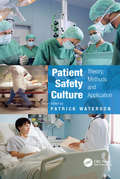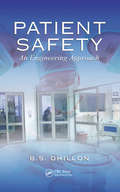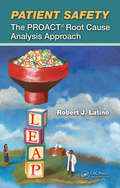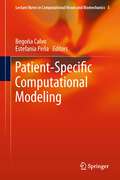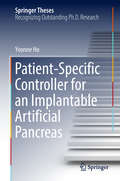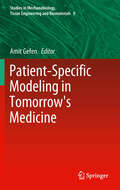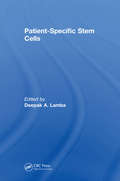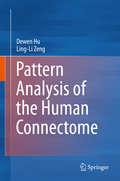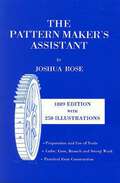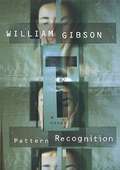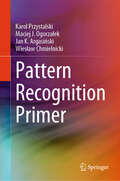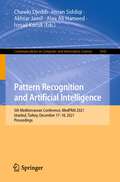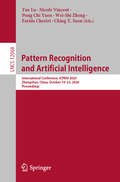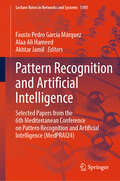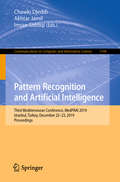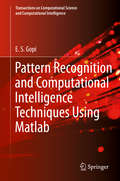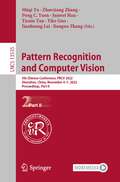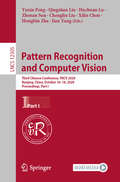- Table View
- List View
Patient Safety Culture: Theory, Methods and Application
by Patrick WatersonHow safe are hospitals? Why do some hospitals have higher rates of accident and errors involving patients? How can we accurately measure and assess staff attitudes towards safety? How can hospitals and other healthcare environments improve their safety culture and minimize harm to patients? These and other questions have been the focus of research within the area of Patient Safety Culture (PSC) in the last decade. More and more hospitals and healthcare managers are trying to understand the nature of the culture within their organisations and implement strategies for improving patient safety. The main purpose of this book is to provide researchers, healthcare managers and human factors practitioners with details of the latest developments within the theory and application of PSC within healthcare. It brings together contributions from the most prominent researchers and practitioners in the field of PSC and covers the background to work on safety culture (e.g. measuring safety culture in industries such as aviation and the nuclear industry), the dominant theories and concepts within PSC, examples of PSC tools, methods of assessment and their application, and details of the most prominent challenges for the future in the area. Patient Safety Culture: Theory, Methods and Application is essential reading for all of the professional groups involved in patient safety and healthcare quality improvement, filling an important gap in the current market.
Patient Safety: A Human Factors Approach
by Sidney DekkerIncreased concern for patient safety has put the issue at the top of the agenda of practitioners, hospitals, and even governments. The risks to patients are many and diverse, and the complexity of the healthcare system that delivers them is huge. Yet the discourse is often oversimplified and underdeveloped. Written from a scientific, human factors
Patient Safety: An Engineering Approach
by B.S. DhillonWith unintended harm during hospital care costing billions of dollars to the world economy, not to mention millions of deaths each year, it's no wonder the issue is equally front and center in the minds of healthcare providers and the public. Although the issue has been tackled in journal articles and conference proceedings, there are very few book
Patient Safety: The PROACT Root Cause Analysis Approach
by Robert J. LatinoAre you ready and willing to get to the root causes of problems? As Medicare, Medicaid, and major insurance companies increasingly deny payment for never events, it has become imperative that hospitals and doctors develop new ways to prevent these avoidable catastrophes from recurring. Proactive tools such as root cause analysis (RCA), basic failur
Patient Zero: A Joe Ledger Novel (Joe Ledger Ser. #1)
by Jonathan Maberry'When you have to kill the same terrorist twice in one week, then there's either something wrong with your skills or something wrong with your world. And there's nothing wrong with my skills.'Police officer Joe Ledger, martial arts expert, ex-army, self-confessed brutal warrior is scared. The man he's just killed is the same man he killed a week ago. He never expected to see the man again, definitely not alive, and definitely not as part of the recruitment process for the hyper-secret government agency the Department for Military Sciences. But the DMS are scared too: they have word of a terrorist plot straight from a nightmare - a bid to spread a plague through America - a plague that kills its victims and turns them into zombies.Time is running out and Joe has shown he has the abilities they need to lead one of their field teams.And so begins a desperate three-part mission - to contain the zombie outbreaks, to break the terrorist cell responsible and to find the man in their own team who is selling them out to the terrorists.Patient Zero is astonishingly fast moving, incredibily violent and down-right terrifying thriller - a new breed of thriller of techo-thriller that plays on our fears of mad science.
Patient-Specific Computational Modeling
by Begoña Calvo Lopez Estefanía PeñaThis book addresses patient-specific modeling. It integrates computational modeling, experimental procedures, imagine clinical segmentation and mesh generation with the finite element method (FEM) to solve problems in computational biomedicine and bioengineering. Specific areas of interest include cardiovascular problems, ocular and muscular systems and soft tissue modeling. Patient-specific modeling has been the subject of serious research over the last seven years and interest in the area is continually growing and this area is expected to further develop in the near future.
Patient-Specific Controller for an Implantable Artificial Pancreas (Springer Theses)
by Yvonne HoThe thesis focuses on the control of blood glucose devices and design of implantable devices, and offers valuable insights on diabetes mellitus and related physiology and treatments. Diabetes mellitus is a widespread chronic disease in the modern world that affects millions of people around the globe. In Singapore, one in ten of the population has diabetes, and the severity of the problem has prompted the country’s prime minister to talk about the disease at the National Day Rally in 2017. Designing an artificial pancreas that can provide effective blood glucose control for individuals with diabetes is one of the most challenging engineering problems. The author reports on research into the development of an implantable artificial pancreas that can regulate blood glucose levels by delivering appropriate dosages of insulin when necessary. By sensing blood glucose and injecting insulin directly into the vein, the implantable device aims to remove delays that occur with subcutaneous blood glucose sensing and insulin delivery. Preliminary in-vitro and in-vivo experimental results suggest that the implantable device for blood glucose control could be a clinically viable alternative to pancreas transplant.
Patient-Specific Modeling in Tomorrow's Medicine
by Amit GefenThis book reviews the frontier of research and clinical applications of Patient Specific Modeling, and provides a state-of-the-art update as well as perspectives on future directions in this exciting field. The book is useful for medical physicists, biomedical engineers and other engineers who are interested in the science and technology aspects of Patient Specific Modeling, as well as for radiologists and other medical specialists who wish to be updated about the state of implementation.
Patient-Specific Modeling of the Cardiovascular System
by Roy C.P. KerckhoffsThe main purpose of the book is to demonstrate the design of a variety of patient-specific models within the cardiovascular system in computational biology. The maturation of computational biology could lead to a new approach to medicine. During the last five to ten years, there have been many improvements in diagnostic medical technologies such as multi-slice cardiac CT imaging, 3-D electroanatomic mapping, and many types of applications of Magnetic Resonance Imaging (i.e. magnetic resonance tagging and diffusion tensor imaging). Combined with more powerful computing resources and more accurate predictive computational models it is feasible to begin developing mechanistic patient-specific models that may help diagnosis, guide therapy or surgery, and predict outcomes of the latter. Many questions need to be answered before computational modeling can be fully integrated with standard care, such as what is the minimal data set needed from the patient in order to build a reliable predictive model? What accuracy is needed? How will the initial baseline model be validated? What are reasonable computation times? Is some type of perturbation of the patient's physiology necessary? How could they be integrated with current practices? Are physicians willing to accept these models? These questions will also serve as guidelines throughout the chapters. The book will try to cover, such as cardiac electrophysiology, cardiac (muscle) mechanics, circulation dynamics, arterial and venous flow, angiogenesis, remodeling, metabolism, or combinations between these such as cardiac electromechanics or fluid-solid interactions.
Patient-Specific Stem Cells
by Deepak A. LambaOne of the biggest challenges faced in medical research had been to create accurate and relevant models of human disease. A number of good animal models have been developed to understand the pathophysiology. However, not all of them reflect the human disorder, a classic case being Usher’s syndrome where the mutant mice do not have the same visual and auditory defects that patients face. There are others which have been even more difficult to model due to the multi-factorial nature of the condition and due to lack of discovery of a single causative gene such as age-related macular degeneration or Alzheimer’s syndrome. Thus a more relevant and accurate system will allow us to make better predictions on relevant therapeutic approaches. <P><P>The discovery of human pluripotent stem cells in 1998 followed by the technological advances to reprogram somatic cells to pluripotent-stem cell-like cells in 2006 has completely revolutionized the way we can now think about modelling human development and disease. This now coupled with genome editing technologies such as TALENS and CRISPRs have now set us up to develop in vitro models both 2D as well as 3D organoids, which can more precisely reflect the disease in the patients. These combinatorial technologies are already providing us with better tools and therapeutics in drug discovery or gene therapy. <P><P>This book summarizes both the technological advances in the field of generation of patient specific lines as well as various gene editing approaches followed by its applicability in various systems. The book will serve as a reference for the current state of the field as it: <li>Provides a comprehensive overview of the status of the field of patients derived induced pluripotent stem cells. <li>Describes the use of cardiac cells as a main featured component within the book. <li>Examines drug toxicity analysis as a working example throughout the book.
Patriot Games: An outstanding Jack Ryan thriller, now available in eBook for the very first time (Jack Ryan #2)
by Tom Clancy'A novel that crackles!' New York TimesAs an American in London on vacation with his family, Jack Ryan never imagined his quick thinking would prevent an assassination attempt on Britain's royal family and earn him the gratitude of an entire nation - and the scorn of an ultra-left-wing faction of the IRA. Irish terrorist Sean Miller and his followers in the Ulster Liberation Army intend to make sure Ryan pays for his interference in blood. But he's not the only one they're after . . .With the lives of his pregnant wife and young daughter in mortal danger, Ryan accepts a role as a CIA analyst in order to find Miller and shut down the ULA. Going head to head with a ruthless terrorist is a fool's errand, but Jack Ryan is the kind of man who will do whatever it takes to protect his family.
Patrons, Curators, Inventors and Thieves
by Jonathan WheeldonJonathan Wheeldon offers a rare and unusually reflective insider account of the transformational challenges of the music industry, and the cultural industries in general, over the past 15 years. He also makes a potentially valuable contribution to loosening the industrial-political deadlock in the debate over copyright reform.
Pattern Analysis of the Human Connectome
by Dewen Hu Ling-Li ZengThis book presents recent advances in pattern analysis of the human connectome. The human connectome, measured by magnetic resonance imaging at the macroscale, provides a comprehensive description of how brain regions are connected. Based on machine learning methods, multiviarate pattern analysis can directly decode psychological or cognitive states from brain connectivity patterns. Although there are a number of works with chapters on conventional human connectome encoding (brain-mapping), there are few resources on human connectome decoding (brain-reading). Focusing mainly on advances made over the past decade in the field of manifold learning, sparse coding, multi-task learning, and deep learning of the human connectome and applications, this book helps students and researchers gain an overall picture of pattern analysis of the human connectome. It also offers valuable insights for clinicians involved in the clinical diagnosis and treatment evaluation of neuropsychiatric disorders.
Pattern Maker's Assistant: Lathe Work, Branch Work, Core Work, Sweep Work / Practical Gear Construction / Preparation and Use of Tools
by Joshua RoseThis book is as useful today as it was over 100 years ago. It was written then to give machinists practical instruction on how to design and construct patterns; in doing so it describes the actual pattern shop practice of the late 19th century, using the terms and methods of that period. Joshua Rose explains the various types of patterns, how they are constructed, and the tools that are used. This is a reprint of the sixth edition, which gives some indication of the popularity of the book among late 19th century practitioners.
Pattern Recognition
by William GibsonThe accolades and acclaim are endless for William Gibson's coast-to-coast bestseller. Set in the post-9/11 present, Pattern Recognition is the story of one woman's never-ending search for the now.
Pattern Recognition Primer
by Karol Przystalski Jan K. Argasiński Maciej J. Ogorzałek Wiesław ChmielnickiThis textbook provides semester-length coverage of pattern recognition/classification, accessible to everyone who would like to understand how pattern recognition and machine learning works. It explores the most commonly used classification methods in an intelligible way. Unlike other books available for this course, this one explains from top to bottom each method with all needed details. Every method described is explained with examples in Python. The presentation is designed to be highly accessible to students from a variety of disciplines, with no experience in machine learning. Each chapter contains easy to understand code samples, as well as exercises to consolidate and test knowledge.
Pattern Recognition and Artificial Intelligence: 5th Mediterranean Conference, MedPRAI 2021, Istanbul, Turkey, December 17–18, 2021, Proceedings (Communications in Computer and Information Science #1543)
by Chawki Djeddi Akhtar Jamil Imran Siddiqi Alaa Ali Hameed İsmail KucukThis book constitutes the refereed proceedings of the 5th Mediterranean Conference on Pattern Recognition and Artificial Intelligence, MedPRAI 2021, held in Istanbul, Turkey, in December 2021. Due to the COVID-19 pandemic, MedPRAI 2021 was held fully online.The 28 revised full papers and 4 short papers presented were thoroughly reviewed and selected from 72 submissions. The papers are covering the topics of recent advancements in different areas of pattern recognition and artificial intelligence, such as statistical, structural and syntactic pattern recognition, machine learning, data mining, neural networks, computer vision, multimedia systems, information retrieval, etc.
Pattern Recognition and Artificial Intelligence: International Conference, ICPRAI 2020, Zhongshan, China, October 19–23, 2020, Proceedings (Lecture Notes in Computer Science #12068)
by Farida Cheriet Ching Y. Suen Yue Lu Nicole Vincent Pong Chi Yuen Wei-Shi ZhengThis book constitutes the proceedings of the Second International Conference on Pattern Recognition and Artificial Intelligence, ICPRAI 2020, which took place in Zhongshan, China, in October 2020. The 49 full and 14 short papers presented were carefully reviewed and selected for inclusion in the book. The papers were organized in topical sections as follows: handwriting and text processing; features and classifiers; deep learning; computer vision and image processing; medical imaging and applications; and forensic studies and medical diagnosis.
Pattern Recognition and Artificial Intelligence: Selected papers from the 6th Mediterranean Conference on Pattern Recognition and Artificial Intelligence (MedPRAI24) (Lecture Notes in Networks and Systems #1393)
by Fausto Pedro García Márquez Akhtar Jamil Alaa Ali HameedThis book presents a diverse collection of cutting-edge research from the 6th Mediterranean Conference on Pattern Recognition and Artificial Intelligence (MedPRAI24). Covering a wide range of topics, it explores the latest advancements in AI-driven applications, including machine learning for healthcare, cybersecurity, historical document analysis, and digital media. Readers will find studies on AI in social sciences, literature, and governance, alongside technical innovations in image processing, speech analysis, and deep learning. With interdisciplinary contributions spanning engineering, humanities, and political sciences, this volume provides valuable insights into the evolving role of artificial intelligence across multiple domains.
Pattern Recognition and Artificial Intelligence: Third Mediterranean Conference, MedPRAI 2019, Istanbul, Turkey, December 22–23, 2019, Proceedings (Communications in Computer and Information Science #1144)
by Chawki Djeddi Akhtar Jamil Imran SiddiqiThis book constitutes the refereed proceedings of the Third Mediterranean Conference on Pattern Recognition and Artificial Intelligence, MedPRAI 2019, held in Istanbul, Turkey, in December 2019.The 18 revised full papers and one short paper presented were carefully selected from 54 submissions. The papers are covering the topics of recent advancements in different areas of pattern recognition and artificial intelligence, such as statistical, structural and syntactic pattern recognition, machine learning, data mining, neural networks, computer vision, multimedia systems, information retrieval, etc.
Pattern Recognition and Classification
by Geoff DoughertyThe use of pattern recognition and classification is fundamental to many of the automated electronic systems in use today. However, despite the existence of a number of notable books in the field, the subject remains very challenging, especially for the beginner. Pattern Recognition and Classification presents a comprehensive introduction to the core concepts involved in automated pattern recognition. It is designed to be accessible to newcomers from varied backgrounds, but it will also be useful to researchers and professionals in image and signal processing and analysis, and in computer vision. Fundamental concepts of supervised and unsupervised classification are presented in an informal, rather than axiomatic, treatment so that the reader can quickly acquire the necessary background for applying the concepts to real problems. More advanced topics, such as semi-supervised classification, combining clustering algorithms and relevance feedback are addressed in the later chapters. This book is suitable for undergraduates and graduates studying pattern recognition and machine learning.
Pattern Recognition and Computational Intelligence Techniques Using Matlab (Transactions on Computational Science and Computational Intelligence)
by E. S. GopiThis book presents the complex topic of using computational intelligence for pattern recognition in a straightforward and applicable way, using Matlab to illustrate topics and concepts. The author covers computational intelligence tools like particle swarm optimization, bacterial foraging, simulated annealing, genetic algorithm, and artificial neural networks. The Matlab based illustrations along with the code are given for every topic. Readers get a quick basic understanding of various pattern recognition techniques using only the required depth in math. The Matlab program and algorithm are given along with the running text, providing clarity and usefulness of the various techniques.Presents pattern recognition and the computational intelligence using Matlab;Includes mixtures of theory, math, and algorithms, letting readers understand the concepts quickly;Outlines an array of classifiers, various regression models, statistical tests and the techniques for pattern recognition using computational intelligence.
Pattern Recognition and Computer Vision: 5th Chinese Conference, PRCV 2022, Shenzhen, China, November 4–7, 2022, Proceedings, Part II (Lecture Notes in Computer Science #13535)
by Tieniu Tan Zhaoxiang Zhang Shiqi Yu Jianguo Zhang Yike Guo Jianhuang Lai Pong C. Yuen Junwei HanThe 4-volume set LNCS 13534, 13535, 13536 and 13537 constitutes the refereed proceedings of the 5th Chinese Conference on Pattern Recognition and Computer Vision, PRCV 2022, held in Shenzhen, China, in November 2022.The 233 full papers presented were carefully reviewed and selected from 564 submissions. The papers have been organized in the following topical sections: Theories and Feature Extraction; Machine learning, Multimedia and Multimodal; Optimization and Neural Network and Deep Learning; Biomedical Image Processing and Analysis; Pattern Classification and Clustering; 3D Computer Vision and Reconstruction, Robots and Autonomous Driving; Recognition, Remote Sensing; Vision Analysis and Understanding; Image Processing and Low-level Vision; Object Detection, Segmentation and Tracking.
Pattern Recognition and Computer Vision: Third Chinese Conference, PRCV 2020, Nanjing, China, October 16–18, 2020, Proceedings, Part I (Lecture Notes in Computer Science #12305)
by Jian Yang Qingshan Liu Zhenan Sun Xilin Chen Huchuan Lu Yuxin Peng Hongbin Zha Chenglin LiuThe three-volume set LNCS 12305, 12306, and 12307 constitutes the refereed proceedings of the Third Chinese Conference on Pattern Recognition and Computer Vision, PRCV 2020, held virtually in Nanjing, China, in October 2020. The 158 full papers presented were carefully reviewed and selected from 402 submissions. The papers have been organized in the following topical sections: Part I: Computer Vision and Application, Part II: Pattern Recognition and Application, Part III: Machine Learning.
Pattern Recognition and Computer Vision: Third Chinese Conference, PRCV 2020, Nanjing, China, October 16–18, 2020, Proceedings, Part II (Lecture Notes in Computer Science #12306)
by Jian Yang Qingshan Liu Zhenan Sun Xilin Chen Huchuan Lu Yuxin Peng Hongbin Zha Chenglin LiuThe three-volume set LNCS 12305, 12306, and 12307 constitutes the refereed proceedings of the Third Chinese Conference on Pattern Recognition and Computer Vision, PRCV 2020, held virtually in Nanjing, China, in October 2020. The 158 full papers presented were carefully reviewed and selected from 402 submissions. The papers have been organized in the following topical sections: Part I: Computer Vision and Application, Part II: Pattern Recognition and Application, Part III: Machine Learning.
